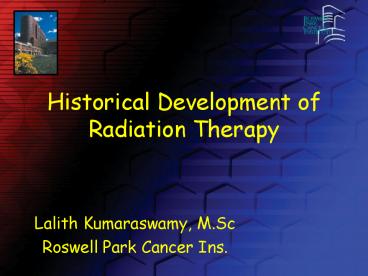Historical Development of Radiation Therapy - PowerPoint PPT Presentation
1 / 39
Title:
Historical Development of Radiation Therapy
Description:
8 November 1895, external effects from the various vacuum tubes. ... Antoine Henri Becquerel. In 1896, he discovered the phenomenon natural Radioactivity. ... – PowerPoint PPT presentation
Number of Views:3075
Avg rating:3.0/5.0
Title: Historical Development of Radiation Therapy
1
Historical Development of Radiation Therapy
- Lalith Kumaraswamy, M.Sc
- Roswell Park Cancer Ins.
2
(No Transcript)
3
(No Transcript)
4
Discovery of X-raysWilhelm Conrad Röntgen
- 8 November 1895, external effects from the
various vacuum tubes. - Fluorescent effect on barium coated screen.
- He saw the shadows of the bones of his hand.
- "I have seen my death!
- Earned the first Nobel Prize for discovering the
X-rays.
5
First American X-Ray
- Dartmouth NH, February 1896.
6
Western NY first X-ray machine
7
Discovery of RadioactivityAntoine Henri
Becquerel
- In 1896, he discovered the phenomenon natural
Radioactivity. - Connection between X-rays and phosphorescence.
- Rays emitted by uranium caused gases to ionize.
- Unlike X-rays, these rays can be deflected by
electric or magnetic field. - He won the Nobel Prize in 1903 for discovering
spontaneous radioactivity.
8
Discovery of Radium Polonium
- Creation of a theory of Radioactivity.
- Using the electrometer her husband built, she
discovered uranium salts caused sample to conduct
electricity. - Activity only depends on the amount of uranium
present. - She discovered that pitchblend is about 4 times
as active as uranium. - Discovery of Polonium Radium.
Marie Curie
9
First Therapy
- First patient was treated with radiation in 1896,
two months after discovery of X-rays. - Rose Lee a 65 year old woman with locally
recurrent breast cancer - Treating physician was a Chicago medical student
named Emil Grubbe
10
The 1st Radiation Oncologist
11
Fractionation
- At first, Radiotherapy was delivered primarily in
a limited number of treatments (Breast
superficial lesions) - Claude Regaud Introduced Fractionation (1920s).
12
Fractionation
- The early French Radiation Oncologist Henri
Coutard pioneered the use of fractionated
Radiotherapy in a wide variety of tumors.
13
Limitations
- X-ray machines inability to produce high
energy, deep penetrating beams. - Thus difficult to treat deep-seated tumors
without excessive skin reactions.
14
Brachytherapy
- Placed radioactive sources close proximity or
within the tumor. - Cervical and uterine cancers, brachytherapy
became the mainstay of treatment.
15
Patterson-Parker
- Following World War II, England became the
primary focus for Radiotherapy research. - Ralston Patterson Herbert Parker developed
Patterson-Parker rules for Brachytherapy.
16
Patterson-Parker rules
- Rules were developed uniform dose (/- 10) to a
plane or volume. - Provided rules of source distribution.
17
Co-60 Unit
- Scientists tried building sources of ionizing
radiation called "radium bombs" for teletherapy. - But radium radiation was too weak for the job.
- In 1949, Dr. Harold Johns of the University of
Saskatchewan approched Wilfrid Bennett Lewis, the
director of the Atomic Energy Division of the
National Research Council (NRC), requesting that
cobalt-60 produced by the NRX reactor be used in
the construction of a prototype cobalt therapy
unit.
18
Co-60 Unit
- Physics team headed by Dr. Harold Johns ---
Saskatoon, Saskatchewan. - Physician Engineering team headed by Eldorado
Mining and Refining Ltd --- University of Western
Ontario. - First treatment occurred on October 1951, just 4
days after installation.
19
Linear Accelerator
- Henry Kaplan, MD Ed Ginzton developed the first
medical linear accelerator in North America.
20
Linear Accelerator
- 1.65 m long accelerator guide.
- Max Field size of 15x15.
- Dose rate of 100 cGy/min at 1m.
21
Linear Accelerator
- First patient was a two year old boy with
retinoblastoma in 1957. - The patient is still living with normal vision.
22
Modern Linac
- Multiple electron photon energies.
- Increased X-ray energy.
- Beam shaping devices.
23
Area of technical advances
- Seeing better
- Planning better
- Treating better
24
Seeing better
25
3D information
26
MRI aids in target delineation
Y Cao, University of Michigan
27
PET/CT
- Multislice CT scanner mated to a PET scanner
- Possibly three scans acquired during procedure
- Attenuation correction CT
- PET
- Treatment planning CT, with contrast if
necessary
28
- 50 yr old women with non-small cell lung cancer.
- PET shows multiple hyper metabolic activity in
the anterior cervical region.
29
Planning Better
30
IMRT
- Allows radiation to be directed more precisely to
the tumor. - Dose escalation.
31
IMRT
32
Treating betterMulti leaf collimator
- Tungsten.
- 20 120 leafs arranged in pairs.
- Efficiency.
- IMRT.
33
Improving Precision and Accuracy
IGRT IMRT
Accurate Not Precise
Precise Not Accurate
Accurate And Precise
34
(No Transcript)
35
(No Transcript)
36
Future ??
37
HIV Virus
HIV Virus 10,000 nucleotides
38
HIV Virus
HIV Virus 10,000 nucleotides
Human DNA 3 billion base pairs
39
- Thank You

